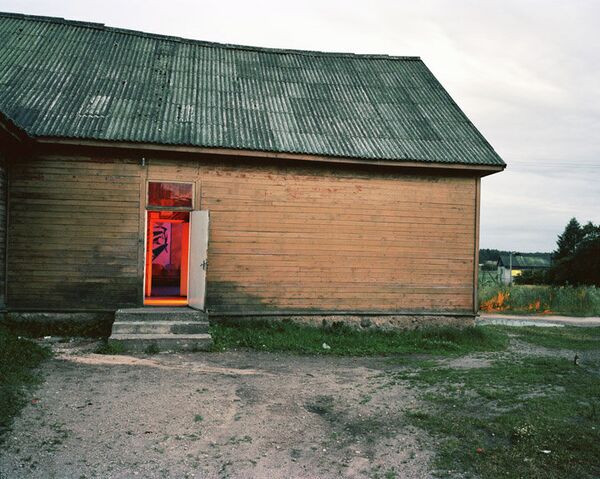WASHINGTON, June 18 (By Carl Schreck for RIA Novosti) – Seattle photographer Andrew Miksys was in the eastern Lithuanian village of Svencionys in 2000 when he spotted young people walking into a Soviet-era cultural center.
“I followed them and found there was a disco there,” Miksys, 43, told RIA Novosti in a telephone interview from the Lithuanian capital of Vilnius.
The discovery planted the seed for a decade-long project in which Miksys, who splits time between Seattle and Vilnius, roamed the Baltic country photographing rural nightclubs catering to youth with limited options for weekend entertainment.
Miksys, who plans to publish the results of his countryside club-hopping in book form later this year, said he found it particularly striking how these cultural centers – a staple of civic life in towns across the Soviet Union – were being used as party venues for an increasingly Westernized youth population in the wake of the Soviet collapse.

A girl dancing at a disco in the Lithuanian village of Svencionys in 2000 with a cast-iron head of Bolshevik leader Vladimir Lenin mounted on the wall. Credit: Andrew Miksys
In the backrooms of these makeshift discos he would often find Soviet-era movie posters, gas masks and broken pictures of Bolshevik leader Vladimir Lenin, “all this debris of a dead empire,” Miksys told RIA Novosti.
“The contrast between the past and the present made for an interesting environment to shoot,” he said.
The project, titled “Disko,” includes photographs showing the clubs’ clientele partying the night away amid Spartan surroundings, including dusty dance floors and jerry-rigged sound systems. He also captures intimate moments of couples slow-dancing or stealing away for a romantic embrace.

A couple slow dancing at a rural disco in Pajuodupis, Lithuania, in 2004. Credit: Andrew Miksys
Having wrapped up shooting for the project in 2010, Miksys said his project documented a decade in which young people were uncertain about the future of Lithuania, which declared independence from the Soviet Union in 1990 and secured widespread recognition the following year after a bloody attempt by Moscow to halt the secession.
Many of the Soviet-era remnants disappeared from these rural discos during his decade of work on the project – as did many of the young people, said Miksys, whose father and grandparents fled Soviet-controlled Lithuania following World War II.
“This is the economic reality, especially for people living in rural Lithuania,” he said “You sort of have to leave to be successful, and so young people left.”

Young Lithuanians dancing as DJs look on from above at a disco in the town of Adutiškis in 2008. Credit: Andrew Miksys
Lithuania, a country of 3.5 million, has seen more than 600,000 of its citizens move abroad since 1990, including more than 440,000 between 2001 and 2011, according to government statistics. The bulk of these émigrés have relocated to Western Europe in search of work – Britain and Ireland are notably popular destinations – while demographers say rural Lithuanian towns have seen the most rapid decline.
Miksys traveled primarily in eastern Lithuania near the border with Belarus for the project, visiting around 15 Lithuania towns and villages with populations ranging from a few hundred people to around 5,000.
The young people he met at the discos were often shocked that he had come all the way from the United States to shoot photographs in their out-of-the-way communities, said Miksys, adding that his accented Lithuanian does not exactly help him to blend in.
He said he often managed to befriend the DJs, bartenders and the club organizers, however, which helped facilitate his work.
At the disco in Svencionys – the club that inspired the project – the bartender noticed how much attention the photographer was paying to a cast-iron face of Lenin mounted on the wall, Miksys said. Around his third time at the club she decided to give it to him.
“She noticed how much I liked it and said they were about to remodel and thought it would be thrown out,” he said. “I have it in my storage space in Seattle.”


